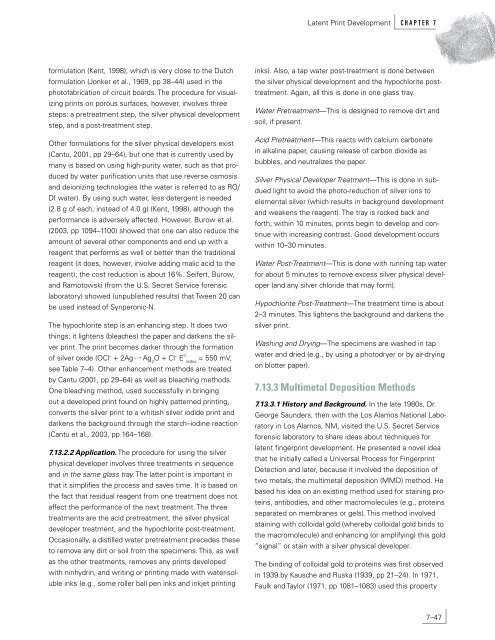Latent Print Development - National Criminal Justice Reference ...
Latent Print Development - National Criminal Justice Reference ...
Latent Print Development - National Criminal Justice Reference ...
Create successful ePaper yourself
Turn your PDF publications into a flip-book with our unique Google optimized e-Paper software.
formulation (Kent, 1998), which is very close to the Dutch<br />
formulation (Jonker et al., 1969, pp 38–44) used in the<br />
photofabrication of circuit boards. The procedure for visualizing<br />
prints on porous surfaces, however, involves three<br />
steps: a pretreatment step, the silver physical development<br />
step, and a post-treatment step.<br />
Other formulations for the silver physical developers exist<br />
(Cantu, 2001, pp 29–64), but one that is currently used by<br />
many is based on using high-purity water, such as that produced<br />
by water purification units that use reverse osmosis<br />
and deionizing technologies (the water is referred to as RO/<br />
DI water). By using such water, less detergent is needed<br />
(2.8 g of each, instead of 4.0 g) (Kent, 1998), although the<br />
performance is adversely affected. However, Burow et al.<br />
(2003, pp 1094–1100) showed that one can also reduce the<br />
amount of several other components and end up with a<br />
reagent that performs as well or better than the traditional<br />
reagent (it does, however, involve adding malic acid to the<br />
reagent); the cost reduction is about 16%. Seifert, Burow,<br />
and Ramotowski (from the U.S. Secret Service forensic<br />
laboratory) showed (unpublished results) that Tween 20 can<br />
be used instead of Synperonic-N.<br />
The hypochlorite step is an enhancing step. It does two<br />
things: it lightens (bleaches) the paper and darkens the silver<br />
print. The print becomes darker through the formation<br />
of silver oxide (OCl – + 2Ag Ag O + Cl 2 – E o<br />
= 550 mV;<br />
redox<br />
see Table 7–4). Other enhancement methods are treated<br />
by Cantu (2001, pp 29–64) as well as bleaching methods.<br />
One bleaching method, used successfully in bringing<br />
out a developed print found on highly patterned printing,<br />
converts the silver print to a whitish silver iodide print and<br />
darkens the background through the starch–iodine reaction<br />
(Cantu et al., 2003, pp 164–168).<br />
7.13.2.2 Application. The procedure for using the silver<br />
physical developer involves three treatments in sequence<br />
and in the same glass tray. The latter point is important in<br />
that it simplifies the process and saves time. It is based on<br />
the fact that residual reagent from one treatment does not<br />
affect the performance of the next treatment. The three<br />
treatments are the acid pretreatment, the silver physical<br />
developer treatment, and the hypochlorite post-treatment.<br />
Occasionally, a distilled water pretreatment precedes these<br />
to remove any dirt or soil from the specimens. This, as well<br />
as the other treatments, removes any prints developed<br />
with ninhydrin, and writing or printing made with water-soluble<br />
inks (e.g., some roller ball pen inks and inkjet printing<br />
<strong>Latent</strong> <strong>Print</strong> <strong>Development</strong> C H A P T E R 7<br />
inks). Also, a tap water post-treatment is done between<br />
the silver physical development and the hypochlorite posttreatment.<br />
Again, all this is done in one glass tray.<br />
Water Pretreatment—This is designed to remove dirt and<br />
soil, if present.<br />
Acid Pretreatment—This reacts with calcium carbonate<br />
in alkaline paper, causing release of carbon dioxide as<br />
bubbles, and neutralizes the paper.<br />
Silver Physical Developer Treatment—This is done in subdued<br />
light to avoid the photo-reduction of silver ions to<br />
elemental silver (which results in background development<br />
and weakens the reagent). The tray is rocked back and<br />
forth; within 10 minutes, prints begin to develop and continue<br />
with increasing contrast. Good development occurs<br />
within 10–30 minutes.<br />
Water Post-Treatment—This is done with running tap water<br />
for about 5 minutes to remove excess silver physical developer<br />
(and any silver chloride that may form).<br />
Hypochlorite Post-Treatment—The treatment time is about<br />
2–3 minutes. This lightens the background and darkens the<br />
silver print.<br />
Washing and Drying—The specimens are washed in tap<br />
water and dried (e.g., by using a photodryer or by air-drying<br />
on blotter paper).<br />
7.13.3 Multimetal Deposition Methods<br />
7.13.3.1 History and Background. In the late 1980s, Dr.<br />
George Saunders, then with the Los Alamos <strong>National</strong> Laboratory<br />
in Los Alamos, NM, visited the U.S. Secret Service<br />
forensic laboratory to share ideas about techniques for<br />
latent fingerprint development. He presented a novel idea<br />
that he initially called a Universal Process for Fingerprint<br />
Detection and later, because it involved the deposition of<br />
two metals, the multimetal deposition (MMD) method. He<br />
based his idea on an existing method used for staining proteins,<br />
antibodies, and other macromolecules (e.g., proteins<br />
separated on membranes or gels). This method involved<br />
staining with colloidal gold (whereby colloidal gold binds to<br />
the macromolecule) and enhancing (or amplifying) this gold<br />
“signal” or stain with a silver physical developer.<br />
The binding of colloidal gold to proteins was first observed<br />
in 1939 by Kausche and Ruska (1939, pp 21–24). In 1971,<br />
Faulk and Taylor (1971, pp 1081–1083) used this property<br />
7–47

















